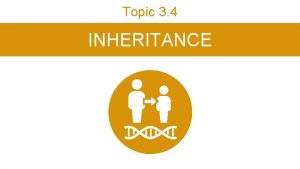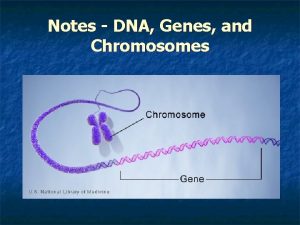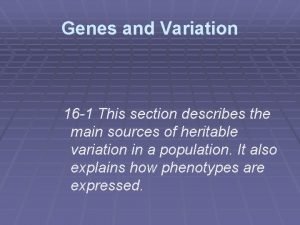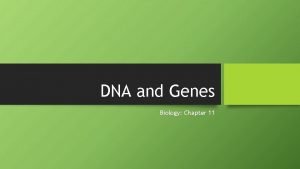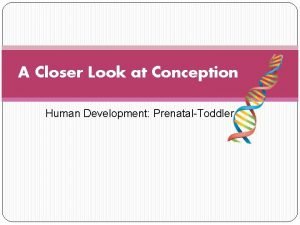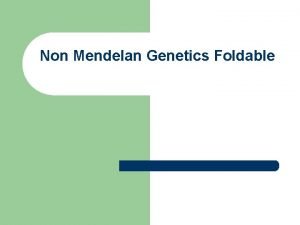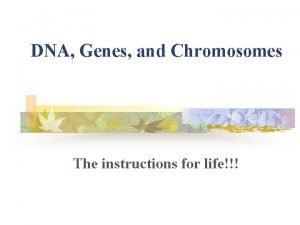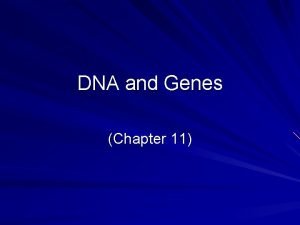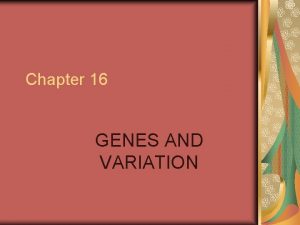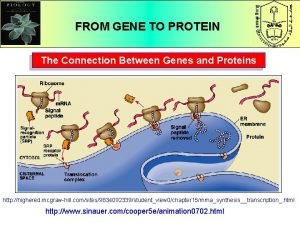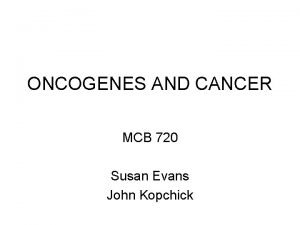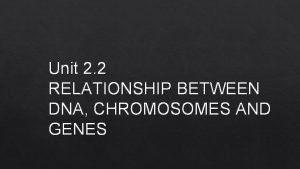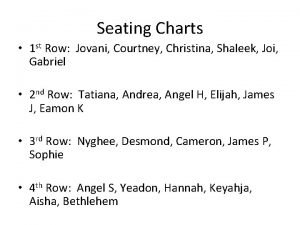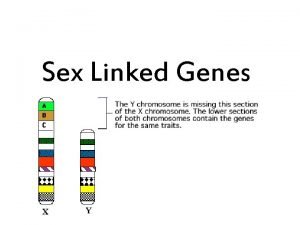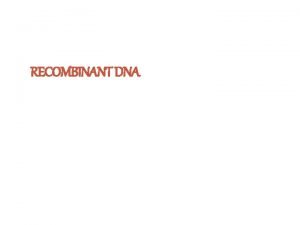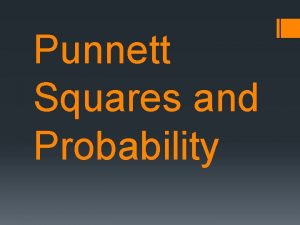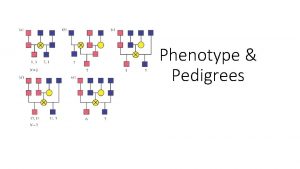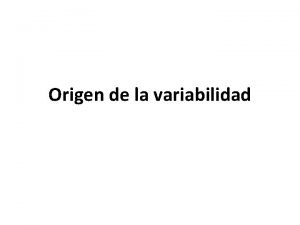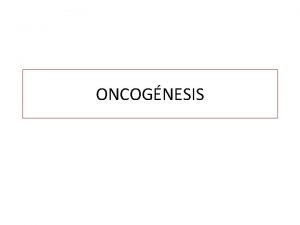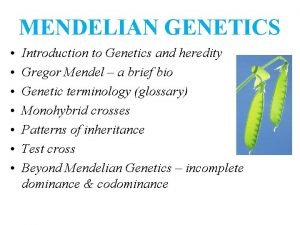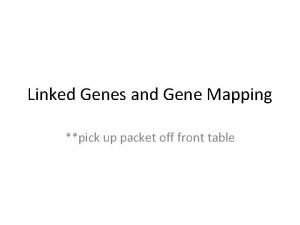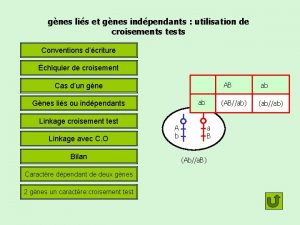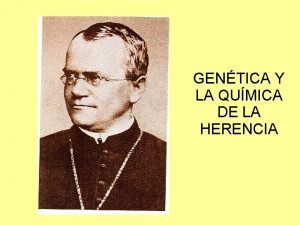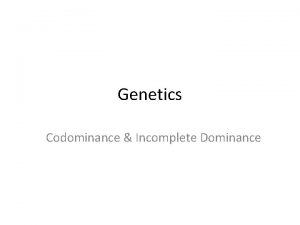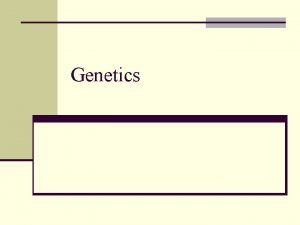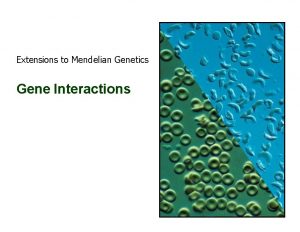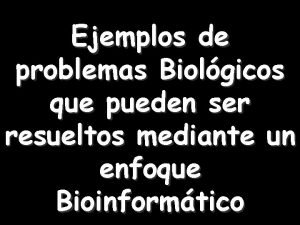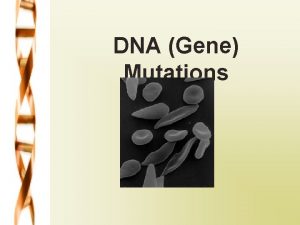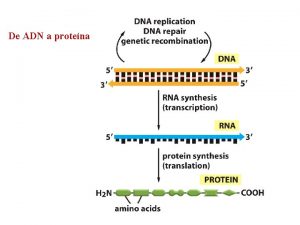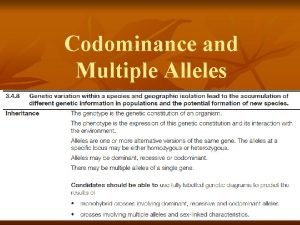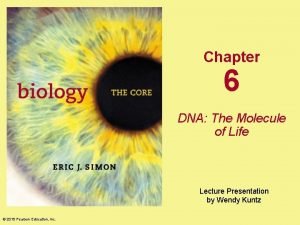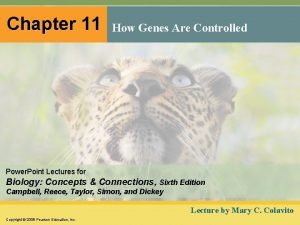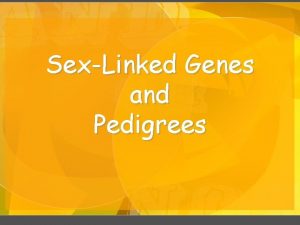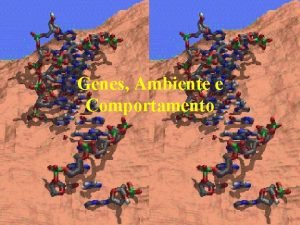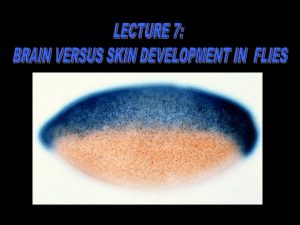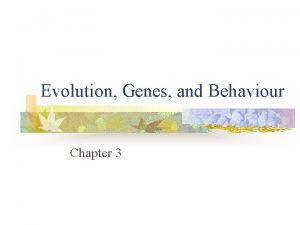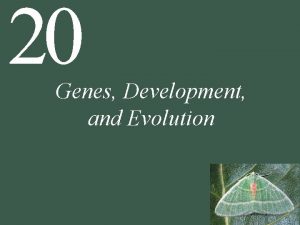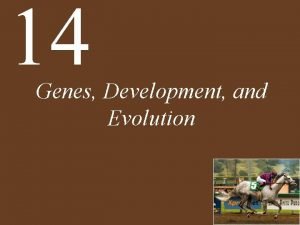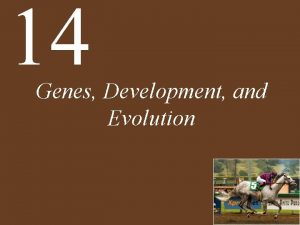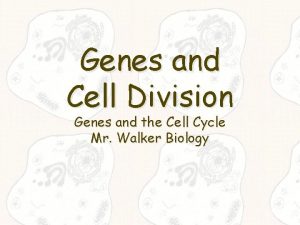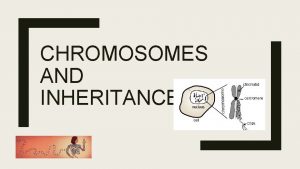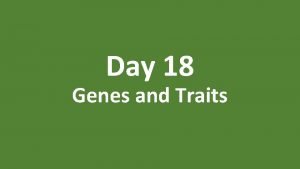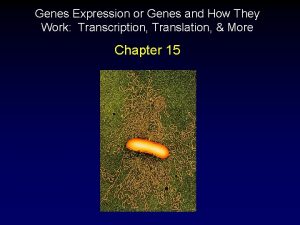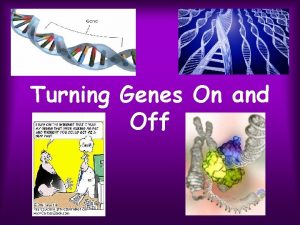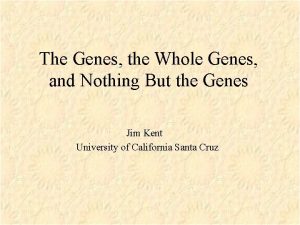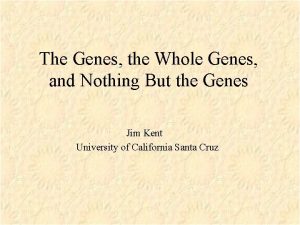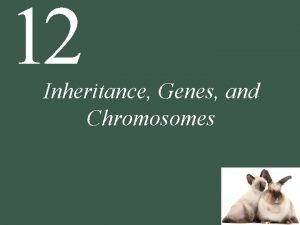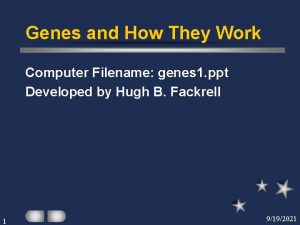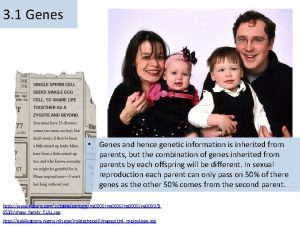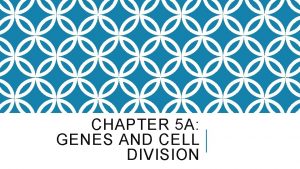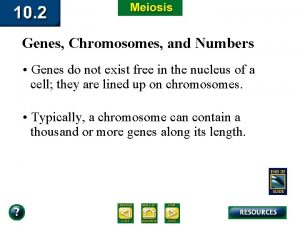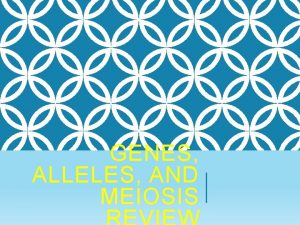Evolution and Genes Introduction to Evolution Evolution is














































- Slides: 46

Evolution and Genes

Introduction to Evolution • Evolution is descent with modification – Darwins ideas were first published in his book On the Origin of Species -Used the phrase “descent with modification”

Darwin was not the first • Jean-Baptiste Lemark first proposed a mechanism before Darwin – He proposed that evolution occurred by the inheritance of acquired characteristics

Darwin’s mechanism • Darwin proposed natural selection – Natural selection produces evolutionary change when in a population some individuals, which possess certain inherited characteristics, produce more surviving offspring than individuals lacking these characteristics.

Natural Selection • For natural selection to happen three conditions must be met: – Variation must exist among individuals in a population. – Variation among individuals results in differences in number of offspring surviving in the next generation. – Variation must be genetically inherited.

Natural Selection acts on Variations in nature • Natural populations can contain a great deal of genetic variation – Enzyme polymorphisms – DNA sequence polymorphisms • Researchers refer to a locus with more variation than can be explained by mutation as polymorphic

Natural selection cause allele frequencies to change • Population genetics is the study of the properties of genes in populations. – Selection, scientists then thought, should always favor an optimal form, and so tend to eliminate variation. – The theory of blending inheritance—in which offspring were expected to be phenotypically intermediate relative to their parents—was widely accepted. – This is something that Darwin had trouble explaining!

Hardy and Weinberg • Following the rediscovery of Mendel’s research two people in 1908 independently solved the puzzle of why genetic variation persists. – G. H. Hardy – English mathematician – W. Weinberg – a German physician

Hardy and Weinberg • Both pointed out that the original proportions of the genotypes in a population will remain constant from generation to generation as long as the following assumptions are met – The population size is very large – Random mating is occurring – No mutation takes place – No genes are input from other sources (immigration or emigration) – No selection occurs

Hardy-Weinberg in algebraic terms

An example • Cycstic fibrosis is a serious human disease that causes thick, sticky mucus to build up in the lungs and digestive tract. This allele is present in North Americans of Caucasian descent at a frequency “q” of about 22 per 1000 individuals. What proportion of North American Caucasians, therefore, is expected to express this trait?

Why do allele frequencies change? • According to the Hardy–Weinberg principle, both the allele and genotype frequencies in a large, random-mating population will remain constant from generation to generation if no mutation, no gene flow, and no selection occur.

Mutation • Mutation from one allele to another can change the proportions of particular alleles in a population. • Very infrequent- a single gene can mutate about 1 to 10 times per 100, 000 cell divisions • Even though its slow it’s the ultimate source of genetic variation • Can transfer advantage, disadvantage or could be neutral

Gene Flow • Gene flow is the movement of alleles from one population to another (i. e. when two populations exchange genes) – Sometimes gene flow is obvious, as when an animal moves from one place to another. – Other are not i. e. drifting of gametes or immature stages of plants or animals from one place to another.

Nonrandom mating • Individuals with certain genotypes sometimes mate with one another more commonly than would be expected (i. e. sexual selection) – Interbreeding – In plants outcrossing (i. e. cross-pollination) vs selfpollination

Genetic Drift • In small populations, frequencies of particular alleles may change drastically by chance alone called genetic drift (this is why a population must be large to be in HWE) • Two related causes of decreases in a population’s size are: – founder effects – bottlenecks

Founder effect • The loss of genetic variation that occurs when a new population is established by a very small number of individuals from a larger population • Iceland population

The Bottleneck Effect • Some natural disaster, epidemic or other natural force greatly reduces a populations numbers

Selection • Darwin pointed out that some individuals leave behind more progeny than others and the rate is affected by phenotype and behavior. The results of this process is selection. – Artificial selection – Natural selection – Sexual selection

Number of individuals in the population • Allele frequencies shift in one direction Range of values for the trait at time 1 Range of values for the trait at time 2 Number of individuals in the population Directional Selection Range of values for the trait at time 3

• Intermediate forms are favored and extremes are eliminated Number of individuals in the population Stabilizing Selection Range of values for the trait at time 1 Range of values for the trait at time 2 Range of values for the trait at time 3

Number of individuals in the population • Forms at both ends of the range of variation are favored • Intermediate forms are selected against Range of values for the trait at time 1 Range of values for the trait at time 2 Number of individuals in the population Disruptive Selection Range of values for the trait at time 3

Peppered Moths

Antibiotic Resistance • Forty or fifty years ago, thanks to anitbiotics, scientists thought medicine had all but eradicated infectious agents as a major health threat. Instead, the past two decades have seen an alarming resurgence of infectious diseases and the appearance of new ones. • Formation of whats termed “super bugs” • Is this artificial selection?

Selection for Gall Size • Gall-making fly has two major predators • Wasps prey on larvae in small galls • Birds eat larvae in large galls

Pesticide Resistance

Heterozygous advantage

Macroevolution and Speciation

Macroevolution • Macroevolutionary studies focus on change that occurs at or above the level of species, in contrast with microevolution, which refers to smaller evolutionary changes (typically described as changes in allele frequencies) within a species or population • There are four types of evolutionary patterns.

Divergent Evolution • Describes two or more species that evolved from a common ancestor. • Adaptive radiation involves numerous divergences from a common ancestor into a number of descendants that have exploited different niches in the environment.

Convergent Evolution • Convergent evolution describes two or more unrelated species that have adopted similar adaptations to their environment.

Parallel Evolution • Parallel evolution describes two or more species that have continued to evolve similar characteristics even after their divergence from a common ancestor.

Co-evolution • Coevolution describes the evolution of one species in response to the evolution of another. Coevolution usually occurs in a predator-prey relationship. Old world swallowtail caterpillar on fringed rue

Species Definition • A species is usually defined as a group of individuals capable of interbreeding • To make new specie you need to disrupt gene flow – Speciation is the formation of new species and can occur in a number of ways • Allopatric speciation • Parasympatric speciation • Sympatric speciation

Allopatric Speciation • Allopatric Speciation- production of species as result of geographic barriers.

Parapatric Speciation • Parapatric speciation is when there is no specific extrinsic barrier to gene flow. The population is continuous but the population does not mate randomly.

Sympatric Speciation • Sympatric speciation is the formation of new species without the presence of a geographic barrier. – Balanced polymorphism- biology occurs when two or more clearly different phenotypes exist in the same population of a species – in other words, the occurrence of more than one form or morph – Polyploidy- possession of more than the normal two sets of chromosomes found in diploid cells – Hybridization- occurs when two distincly different forms of a species (or closely related species that are normally reproductively isolated) mate and produce progeny along a geographic boundary called a hybrid zone.

Reproductive Isolating Mechanisms Prezygotic barriers impede mating or hinder fertilization if mating does occur Habitat isolation Temporal isolation Behavioral isolation Individuals of different species Mechanical isolation Gametic isolation Mating attempt HABITAT ISOLATION Fertilization TEMPORAL ISOLATION BEHAVIORAL ISOLATION MECHANICAL ISOLATION GAMETIC ISOLATION Postzygotic barriers prevent a hybrid zygote from developing into a viable, fertile adult Reduced hybrid viability Reduced hybrid fertility Hybrid breakdown Viable, fertile offspring Fertilization REDUCED HYBRID VIABILITY REDUCED HYBRID FERTILITY HYBRID BREAKDOWN

Linnaeus • Carolus Linnaeus (1707– 1778), a Swedish physician and botanist • Sought to classify life’s diversity “for the greater glory of God. ” • binomial: two-part Latin name of a species • Considered the father of taxonomy

Example • Cassiopea xamachana Cassiopea-genus Xamachana-species

Taxonomy • Linnaeus was a founder of taxonomy, – Branch concerned with naming and classifying organisms. – He developed the two–part, or binomial, system of naming organisms according to genus and species. • Nested classification system, grouping similar species into increasingly general categories. • To Linnaeus, the observation that some species resemble each other did not imply evolutionary kinship, but rather the pattern of their creation.

Modern Taxonomic System

Linking Classification and Phylogeny • Systematists use branching diagrams called phylogenetic trees to depict their hypotheses about evolutionary relationships.

Clades and Cladograms Dear God no more! • Cladogram - A diagram depicting patterns of shared characteristics among species.

Valid Clades Monophyletic- Pertaining to a grouping of species consisting of an ancestral species and all its descendants; a clade Paraphyletic- Pertaining to a grouping of species that consists of an ancestral species and some, but not all, of its descendants. Polyphyletic- Pertaining to a grouping of species derived from two or more different ancestral forms.

Extinction
 Linked genes and unlinked genes
Linked genes and unlinked genes Polygenic inheritance
Polygenic inheritance Homeotic genes
Homeotic genes Evolution of populations section 16-1 genes and variation
Evolution of populations section 16-1 genes and variation Evolution of populations section 16-1 genes and variation
Evolution of populations section 16-1 genes and variation Dominant and recessive genes
Dominant and recessive genes The relationship between genes dna and chromosomes
The relationship between genes dna and chromosomes Learn genetics utah karyotype
Learn genetics utah karyotype Genes is the study of heredity and variation
Genes is the study of heredity and variation Single-gene trait
Single-gene trait Chapter 11 dna and genes
Chapter 11 dna and genes Chapter 16 evolution of populations
Chapter 16 evolution of populations Dominant and recessive genes
Dominant and recessive genes Chromosomes genes and basic genetics foldable answer key
Chromosomes genes and basic genetics foldable answer key Dna, genes and chromosomes relationship
Dna, genes and chromosomes relationship Dna and genes chapter 11
Dna and genes chapter 11 Section 16-1 genes and variation
Section 16-1 genes and variation What is the connection between genes and proteins
What is the connection between genes and proteins Difference between proto oncogene and oncogene
Difference between proto oncogene and oncogene What is the relationship between dna chromosomes and genes
What is the relationship between dna chromosomes and genes Chapter 11 dna and genes
Chapter 11 dna and genes Susie roundpants
Susie roundpants Sex-linked traits examples
Sex-linked traits examples Tools of recombinant dna technology
Tools of recombinant dna technology Punnett square
Punnett square Phenotype pedigree chart
Phenotype pedigree chart Flujo de genes ejemplos
Flujo de genes ejemplos Genes supresores de tumores
Genes supresores de tumores Codominance definition
Codominance definition Que es el flujo genetico
Que es el flujo genetico Linked genes
Linked genes Who wrote this
Who wrote this Genes located
Genes located échiquier de croisement gènes liés
échiquier de croisement gènes liés Genes ligados
Genes ligados Incomplete dominance example in humans
Incomplete dominance example in humans Bill nye genes worksheet answers
Bill nye genes worksheet answers Genes in a bottle
Genes in a bottle What is additive gene action
What is additive gene action Los transposones son genes móviles en un cromosoma
Los transposones son genes móviles en un cromosoma Genes xenologos
Genes xenologos What causes mutations in genes
What causes mutations in genes Genes estructurales
Genes estructurales Codominant genes
Codominant genes Genes on chromosome 11
Genes on chromosome 11 The age of genes chapter 6
The age of genes chapter 6 Tumor suppressor gene
Tumor suppressor gene





